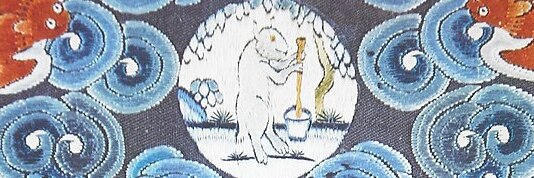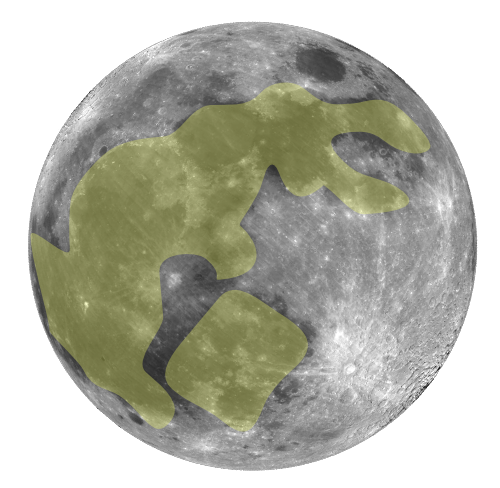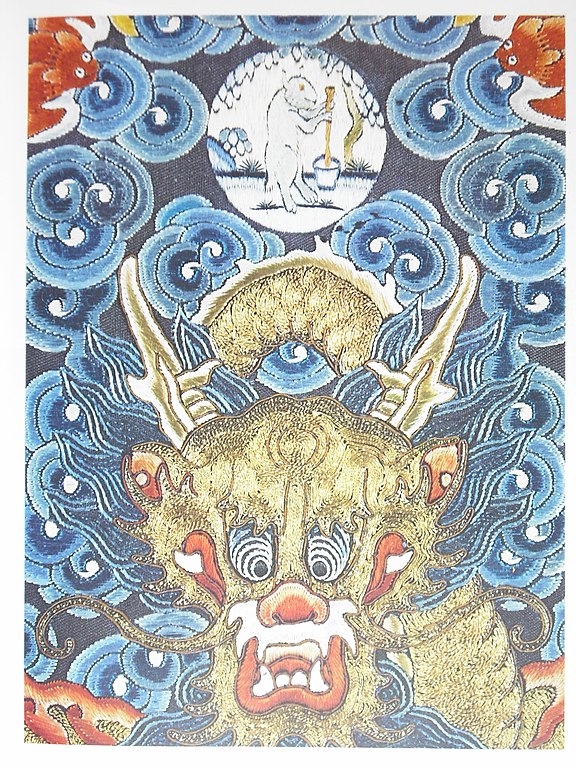The dark markings visible on the near side of the Moon have been subject since ancient times to istances of pareidolia, the tendency to find familiar structures in natural features and artificial objects that have none. Throughout the ages, different cultures have seen various shapes while looking at the Moon, often linked with their mythology or folklore. In Western tradition, the most popular shape seen on the Moon is a face, while in East Asia it is a rabbit.
This interpretation of the markings on the Moon inspired the myth of the Moon rabbit in East Asia, which is seen as pounding with a mortar and pestle. The earliest mention of the myth comes from an anthology of Chinese poems written in the Warring States period called Chu Ci and compiled during the age of the Western Han dynasty. The text mentions the belief that on the Moon there is a hare pounding herbs for immortality, along with a toad. The character here is called “Jade Hare” (玉兔), a name still used today in China. The original figure is a hare as rabbits, native to Europe, were not yet introduced to China at that time.
The shape of a rabbit with a mortar on the lunar surface (Zeimusu, Wikimedia Commons, CC BY-SA 3.0).
This mythological character spread across East Asia, appearing in various legends. A Buddhist myth tells the story of how the rabbit ended up appearing on the Moon’s surface. According to this legend, a monkey, an otter, a jackal, and a rabbit wanted to practice charity on Uposatha, a Buddhist day for meditation that follows the lunar phases. When an old man begged for food, the monkey, the otter, and the jackal collected food for him, but as the rabbit only knew how to gather grass, it offered its own body by jumping in a fire. However, the old man revealed himself as the deity Śakra and, moved by the sacrifice of the rabbit, he decided to draw its figure on the Moon for everyone to see. Similar stories can be found in Chinese and Japanese mythology.
The character also appears in the 16th-century novel Journey to the West, one of the greatest works of Chinese literature. In a scene from this novel, the Moon rabbit is called Jade Rabbit Spirit, and pounds a mortar in a palace on the Moon. One day, the fairy Su’e hit her, and the rabbit bore a grudge against her. After the fairy was reincarnated as the princess of India, the rabbit kidnapped her. The main character of the novel, Sun Wukong, then fought against the Moon rabbit, but the goddess Chang’e stopped him and took the rabbit back to the Moon.
The Moon rabbit is celebrated in various festivals across East Asia, such as the Mid-Autumn Festival in China, Chuseok in Korea, Tsukimi in Japan, Tết Trung Thu in Vietnam, and Sampeah Preah Khae in Cambodia, all of which are held between September and October, around the autumn equinox. The figure appears with different characteristics across these countries. In China, it often accompanies the Moon goddess Chang’e as her pet rabbit, and it is pounding an elixir of immortality, while in some versions it is making medicines or cakes. Instead, in Japanese and Korean folklore, the rabbit is pounding the ingredients for mochi or rice cakes.
Detail of the decorations on the robe of a Chinese emperor from the 18th century, showing a dragon and a rabbit on the Moon making an elixir of immortality.
The legend of the Moon rabbit is curiously present also among indigenous cultures of North and Central America, probably originating from a similar case of lunar pareidolia. In Mayan art, the Moon goddess often appears with a rabbit, and the character is featured in various legends across the region. An Aztec myth features a story similar to the Buddhist myth mentioned above. In this legend, the deity Quetzalcoatl was about to die of starvation during a long journey, when a rabbit offered its body to save his life. Quetzalcoatl then put the image of the rabbit on the Moon so that its offering would be remembered. According to a different Mesoamerican legend, the poor god Nanahuatzin sacrificed himself to become the Sun, while the wealthy god Tēcciztēcatl initially hesitated before turning into the Moon. Due to his hesitation, the other deities punished him by throwing a rabbit at his face, so that the Moon would not shine as bright as the Sun.
In East Asia, the myth of the Moon rabbit is still very popular, and it is often mentioned in modern works of fiction, such as numerous Japanese manga and anime, as well as various video games. Another interesting reference comes from the Chinese Lunar Exploration Program, which named its missions Chang’e, after the lunar goddess of Chinese mythology. As part of the Chang’e 3 mission in 2013, the China National Space Administration launched the lunar rover Yutu (玉兔), literally meaning “Jade Rabbit”. The name was selected in an online poll. The follow-up mission Chang’e 4 included the rover Yutu-2, which made the first soft landing on the far side of the Moon in 2019 and it is still operational.
A reference to the Moon rabbit was even made during the Apollo 11 mission, when the NASA control center humorously warned the crew of the spaceflight to look out for Chang’e and her pet rabbit, while they were on route to set foot on the Moon for the first time.



